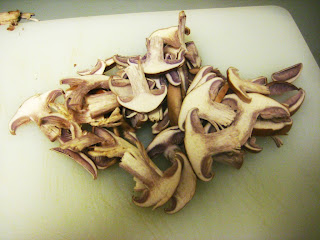A few days a go, I spotted a couple of mushrooms that looked like a brown wood mushroom on my way back home. I took one home to take a closer look and a spore print, and it was one.
So today I thought I'd go back to the same place and see if there are any more (because these things are tasteh!), but I didn't. What I found instead was about 30 shaggy parasols! Initially I thought they were normal parasols, but then they started bruising red so I thought that maybe they are Chlorophyllum molybdites (which is BAD). I was so close to throwing them away, but eventually I took a spore print and they turned out to be shaggy parasols. (They call them "shaggy" because if you walk near one, it starts shagging your show like a dog does.) (No, not really.)
I had a large variety of sizes and shapes to choose from, so I chose young, cup-shaped parasols so I can stuff them with things and cook them and eat them. Like you do when you find tasty-tasty mushrooms.
SO.
4-5 medium-sized parasol mushrooms
1-2 tbsp butter
1-2 tbsp flour
100-200 ml milk (or cream)
2-3 cloves of garlic
½ onion
20-30 g blue cheese
20-30 g yellow cheese
salt and pepper (and other herbs, like dill or sage) to taste
and some more butter to baste.
1. Clean the parasols (but don't wash them because they'll use their taste - just use a wet cloth to scoop off all the dirt and stuff) (and don't be paranoid about it either - the dirt IS going to be cooked at 200˚C, so that's going to kill any germs), and place them in a baking tray/pan, facing upwards. If they don't stay, you can either chop the tops to make them flat, you can pinch them together with toothpicks, or you can make small nests with baking parchment for each one of them.
2. Melt the butter in a pan. Add the flour and mix until it's thick. Slowly add the milk, and then add the garlic and onions.
3. Cook for 4-5 minutes, and then add the spices. (Keep adding milk if it gets too dry.)
4. Fill the parasols with the mixture (butdon't fill them too much; the parasols will shrink as they cook, so the mixture will spill if you top them up), and bake in a pre-heated oven at 180˚C (360˚F) for about 30' (or until they looked cooked and juicy). Also, don't forget to baste with some butter two or three times during baking, so that you don't burn the mushrooms.
You can also stuff them with a lot of other things - a recipe I read mentions veal, others mention parmesan, and others mention sauces made of tomatoes and carrots. So you're obviously free to experiment! The mushroom itself tastes very strongly (and meaty), so it can easily be the main course.
NOTE: The parasol mushroom is known to cause some problems to some people. If you've never had it before, try a little bit first and then more.






































